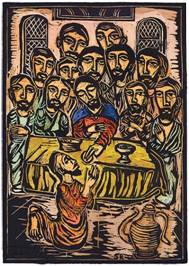THE RAZOR’S EDGE
Distinguishing between healthy and unhealthy religion, Jesus gave us this criterion:
“Does it bear fruit”? (Matthew. 7:15-20)
The metaphor of ‘bearing fruit’: When we speak about God, we can only use metaphors and symbols. That means that whenever we think we know God fully, we are always wrong.
When we know we don’t know fully, we will be more concerned about loving behavior than correct ideas. And so the entire biblical text emphasizes ‘right relationships’ more than ‘being right’.
This is the razor’s edge: finding the balance between knowing and not-knowing.
The two streams: knowing and not-knowing
In the history of Christian spirituality, there have been two distinct ways of learning and praying. The first way has been called the ‘cataphatic’ way – filling the heart and mind with words, images, and knowledge of the Holy. The second way has been called the ‘apophatic’ way – emptying the heart and mind to make space for the Holy to come in.
The apophatic tradition has been underdeveloped in our modern era. But since both ways – filling and emptying – are necessary for our spiritual development, it is crucial to integrate these two streams of knowing and not-knowing.
Remember that Jesus spoke in parables, which are similar to poetry. A good poem doesn’t try to define an experience as much as it tries to give you the experience. A poem tries to awaken your own seeing, hearing and knowing; it doesn’t give you the answer so much as a process through which you can know for yourself.
Desert and mountaintop in scripture
Using two more metaphors, Rohr says “it’s the mountain of knowing and the desert of not-knowing.” The tradition of the mountain is about presence; the tradition of the desert is about absence. The tradition of the mountain is about speaking; the tradition of the desert is about silence.
“The pillar of flame by night and the pillar of cloud by day” (Exodus 13:21f) are both good guides, but not one without the other!
Today’s confusion
Most Christian denominations claim great certainty in their interpretations of Tradition and Scripture (and so many of our religious arguments today stem from that certainty). However, no denomination has taught a parallel and equally serious process of prayer.
Today we are overwhelmed with voluminous and conflicting information. But we can’t settle our confusion by pretending to know all the answers, or arguing that our own religious tradition has the right answers. Instead, we need to learn to pray – a humble process for listening and discernment.
Prayer as the process
The two paths of knowing and not-knowing are primarily taught through prayer.
The prayer of words: Jesus taught his disciples the ‘Lord’s Prayer’, and he encouraged them to ask for what they needed (Luke 11: 1-13). From his Last Supper, Christians developed forms of liturgical prayer often centering around intercession, gratitude and worship.
The prayer beyond words: Jesus told his disciples to “pray in secret” (Matthew 6:5f), and he himself went out for solitary prayer (Mark 1:35f). The example of Jesus’ own prayer point us toward what today we would call contemplation.
Practicing contemplative prayer – and struggling with pain and suffering – are the primary paths to spiritual transformation.
An idolatry of words
Each of the three monotheistic religions offers words, sacred texts, and creeds as their claim to truth. But perfect agreement on words and forms is never going to happen. Instead, we need to invite people into an experience of the Presence.
The great shortcoming of biblical literalism is that it presumes it understands, yet in fact it often misses the deep and profound stirrings of the Spirit.
When Jesus healed, touched, taught and transformed people, he didn’t give them a formal religious education first. He simply taught them with stories, parables, and concrete examples, instead of teaching a system of beliefs.
A concrete example can be a spiritual doorway, because incarnation is always specific and concrete, always in the here and now. (We don’t fall in love with abstractions but with concrete people. This is why the Word became flesh.)
The roundabout way of ‘wilderness’
The people of Israel are said to have wandered in the wilderness for forty years. Rohr writes, “There was apparently a much quicker way than forty years of wandering around in circles, but the real goal was not getting there, it was the journey itself.” Only a journey of faith can create a people of faith.
Rohr’s point? Only people who have first lived and loved, suffered and failed – and then lived and loved again – are in a position to read the scriptures in a humble, needy, inclusive and finally fruitful way.
You shall not take the Name of the Lord your God in vain. (Exodus 20)
The prohibition against speaking ‘the Name of God in vain’ is not really about swearing. Rather, it forbids us to use God’s name casually, or with a false presumption of understanding.
God cannot be known the way we can know a tree, a scientific fact, or a book. God is not an ordinary piece of our experience so much as the Experience that is broad enough and deep enough to allow us to hold all of our other experiences. This God can only be known through a reciprocal knowing, where we “come to know as we are fully known” (1 Corinthians 13:13).
I AM: When Moses asked for God’s name, God replied “I am who I am” or “I will be who I will be” (Exodus 3:1-15). In the Hebrew Bible, this is written as YHWH; to this day observant Jews will not pronounce this name when they come upon it in the scriptures. They understand that God’s eternal mystery cannot be captured or controlled – the mystery can only be spoken and received by the breath itself.
Rohr writes, “Isn’t that the very meaning of Jesus’ breathing on his disciples after the Resurrection? (John 20:22f). The Biblical message comes to a crescendo in the resurrected breath of Jesus, which is Jesus unbound by space or time. So for the rest of your life let your breathing – in and out, in and out – become your prayer. You do not need to prove God’s existence to anyone else. Just keep breathing with full consciousness and without resistance, and you will know what you need to know.” (Things Hidden, p. 131)
Some questions for your reflection:
The prayer of words: Can you remember the first prayers you learned to say?
Liturgical prayer: Think of your experiences in worship. When does the liturgy touch you through words? When does it touch you in ways beyond words?
The prayer beyond words: Once again, think back over your life. Can you remember a time when – without words – you found yourself in God’s presence?





